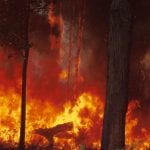Around The Web
Morrison refuses to discuss climate change as Tasmania burns, Townsville floods
 After a particularly harsh summer of extremes, climate change is emerging as a key battleground in the upcoming election. But our PM doesn't want to talk about it.
After a particularly harsh summer of extremes, climate change is emerging as a key battleground in the upcoming election. But our PM doesn't want to talk about it.
The post Morrison refuses to discuss climate change as Tasmania burns, Townsville floods appeared first on RenewEconomy.
Will Australia seize opportunity to lead region’s renewable hydrogen market?
 Australia has the resource, our Asian neighbours and trading partners need it. The opportunity to store and ship renewable energy in bulk, liquid, transportable form exists now.
Australia has the resource, our Asian neighbours and trading partners need it. The opportunity to store and ship renewable energy in bulk, liquid, transportable form exists now.
The post Will Australia seize opportunity to lead region’s renewable hydrogen market? appeared first on RenewEconomy.
Analysis: Why the UK’s CO2 emissions have fallen 38% since 1990
 The UK’s CO2 emissions peaked in the year 1973 and have declined faster than any other major developed country. Here's how.
The UK’s CO2 emissions peaked in the year 1973 and have declined faster than any other major developed country. Here's how.
The post Analysis: Why the UK’s CO2 emissions have fallen 38% since 1990 appeared first on RenewEconomy.
TransGrid appoints Jason Conroy as Chief Financial Officer
 TransGrid today announced the appointment of Jason Conroy to its Executive team as Chief Financial Officer, effective on 4 March 2019.
TransGrid today announced the appointment of Jason Conroy to its Executive team as Chief Financial Officer, effective on 4 March 2019.
The post TransGrid appoints Jason Conroy as Chief Financial Officer appeared first on RenewEconomy.
Elliott Green Power opens Susan River solar farm, two more being built
 Elliott Green Power formally opens Susan River solar farm, the 20th large scale renewable energy project to come on line in Queensland in the last two years.
Elliott Green Power formally opens Susan River solar farm, the 20th large scale renewable energy project to come on line in Queensland in the last two years.
The post Elliott Green Power opens Susan River solar farm, two more being built appeared first on RenewEconomy.
CP Daily: Monday February 4, 2019
Flood waters inundate Townsville homes as army called in – in pictures
Hundreds of residents in Townsville have been evacuated and two men are missing as the area is hit with a year’s worth of rainfall in nine days
• Townsville flooding: two missing as questions mount over dam release
Continue reading...France relies on German coal to heat homes in cold winter
 Germany posts record energy exports in January as France looks for more power to heat homes in absence of eight nuclear plants.
Germany posts record energy exports in January as France looks for more power to heat homes in absence of eight nuclear plants.
The post France relies on German coal to heat homes in cold winter appeared first on RenewEconomy.
$3m deal charges UNSW drive for an integrated renewables future
 UNSW Sydney's $3m deal with Providence Asset Group will accelerate research into reliable energy networks and fund a new centre supporting global development of renewables markets.
UNSW Sydney's $3m deal with Providence Asset Group will accelerate research into reliable energy networks and fund a new centre supporting global development of renewables markets.
The post $3m deal charges UNSW drive for an integrated renewables future appeared first on RenewEconomy.
ICE seeking listing for California offset, WCI and RGGI auction-indexed contracts
French, Indian firms awarded UN offsetting contracts in 2018
Changing shape of solar power: How tracking technology killed the solar bell curve
 Carnegie Clean Energy illustrates the benefits of using single axis tracking in large-scale solar projects.
Carnegie Clean Energy illustrates the benefits of using single axis tracking in large-scale solar projects.
The post Changing shape of solar power: How tracking technology killed the solar bell curve appeared first on RenewEconomy.
Massachusetts distributed nearly 570k additional carbon units under GWSA market, with more to come
Connecticut aiming to finalise RGGI regulation by spring
EU Market: EUAs rally by nearly €2 intraday after hitting 2019 low
'Moth busters' take on unwanted residents of a 17th Century house
There's insufficient evidence your sunscreen harms coral reefs
Virginia publishes revised RGGI proposal, as controversy threatens governor’s tenure
Climate change: Warming threatens Himalayan glaciers
Tasmania is burning. The climate disaster future has arrived while those in power laugh at us | Richard Flanagan
Scott Morrison is trying to scare people about franking credits but seems blithely unaware people are already scared – about climate change
As I write this, fire is 500 metres from the largest King Billy pine forest in the world on Mt Bobs, an ancient forest that dates back to the last Ice Age and has trees over 1,000 years old. Fire has broached the boundaries of Mt Field national park with its glorious alpine vegetation, unlike anything on the planet. Fire laps at the edges of Federation Peak, Australia’s grandest mountain, and around the base of Mt Anne with its exquisite rainforest and alpine gardens. Fire laps at the border of the Walls of Jerusalem national park with its labyrinthine landscapes of tarns and iconic stands of ancient pencil pine and its beautiful alpine landscape, ecosystems described by their most eminent scholar, the ecologist Prof Jamie Kirkpatrick, as “like the vision of a Japanese garden made more complex, and developed in paradise, in amongst this gothic scenery”.
“You have plants that look like rocks – green rocks – and these plants have different colours in complicated mosaics: red-green, blue-green, yellow-green, all together. It’s an overwhelming sensual experience really.”
Continue reading...


